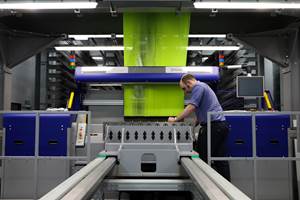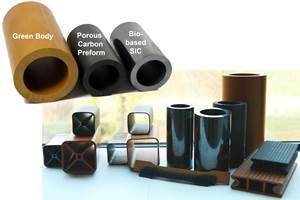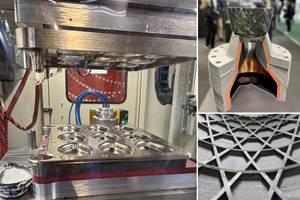CFM LEAP-1B engine begins flight test program
The engine features extensive use of carbon fiber and ceramic matrix composites.
CFM International (Melun, France) started the flight testing of the LEAP-1B engine on April 29 on a modified 747 flying test bed at GE Aviation Flight Test Operations in Victorville, CA.
The testing is the next milestone in a two-year program that will culminate in engine certification in 2016 and delivery of the first Boeing 737 MAX in 2017. The company says that the engine behaved well and completed multiple aeromechanical test points at various altitudes during the five-hour, 30-minute first flight.
"I continue to be really impressed with the LEAP family," said chief test pilot Steven Crane. "These engines are demonstrating a maturity that you don't always see in new products. I think our airline customers are going to be very pleased with this engine."
The LEAP-1B engine is the exclusive power plant for the Boeing 737 MAX family. The first engine began ground testing on June 13, 2014, three days ahead of the schedule set when the program was launched in 2011.
Over the next several weeks, the flight test program will encompass a comprehensive test schedule that will gauge engine operability, stall margin, performance, emissions and acoustics. It will also further validate the advanced technologies incorporated in the engine, including the woven carbon fiber composite fan, the Twin-Annular, Pre-Mixing Swirler (TAPS) combustor, ceramic matrix composite shrouds in the high-pressure turbine and titanium aluminide blades in the low-pressure turbine.
“With this major engine milestone and the test results to date we continue to be confident that the LEAP-1B-powered 737 MAX will provide our customers with the most fuel efficient, reliable and maintainable airplane in the single-aisle market,” said Keith Leverkuhn, vice president and general manager of the 737 MAX program for Boeing Commercial Airplanes. “The 737 MAX is on track to deliver 14% more fuel efficiency than today’s most efficient next-generation 737s and 20% more efficiency than the first next-generation 737s to enter service.”
There are currently a total of 26 LEAP engines (all three models) on test, with 10 additional engines in various stages of final assembly.
"The LEAP engine has been doing incredibly well throughout a very rigorous ground and flight test program," said Allen Paxson, CFM executive vice president. "All of these engines are heavily instrumented, many of them deliberately deteriorated, to calibrate performance and durability in the most extreme conditions. We have successfully completed several major certification tests, including icing, flocking bird ingestion, large-bird ingestion, and even a fan blade-out test. We have passed them all and the results are right in line with what we predicted and where we wanted this engine to be. We are on track to meet all of our commitments at entry into service."
This LEAP-1B engine is part of the most extensive ground and flight test certification program in CFM's history. The total program, which encompasses all three LEAP engine variants, includes 28 ground and CFM flight test engines, along with a total of 32 flight test engines for the aircraft manufacturers. Over a three-year span, these engines will accumulate approximately 40,000 engine cycles leading up to entry into service. By the time this engine enters service, CFM will have simulated more than 15 years of airline service with 60 different engine builds.
In 2011, Boeing selected the LEAP-1B as the sole power plant for its new 737 MAX, extending a more than 30-year relationship. CFM has been the only engine provider for the 737 aircraft family since the 737 Classic entered service in 1984.
Related Content
AMRC fiber handling expertise aids CMC coating technology
The CICSiC project successfully developed equipment and processing know-how associated with the uniform, continuous coating of SiC-based CMC, to bring down cost, and improve performance and reliability for new designs, applications.
Read MoreBio-based SiC ceramics from wood polymer composites
Austrian research institute Wood K plus makes 95% silicon carbide ceramics more sustainable (>85% bio/recycled content), enables 3D shapes via extrusion, injection molding and 3D printing.
Read MoreAMULET project funds 24 projects in composites, CMCs, metals
Trans-European project finalists for first open call identify material and process innovations in building, aerospace and aeronautics, energy and automotive sectors.
Read MoreJEC World 2024 highlights: Thermoplastic composites, CMC and novel processes
CW senior technical editor Ginger Gardiner discusses some of the developments and demonstrators shown at the industry’s largest composites exhibition and conference.
Read MoreRead Next
From the CW Archives: The tale of the thermoplastic cryotank
In 2006, guest columnist Bob Hartunian related the story of his efforts two decades prior, while at McDonnell Douglas, to develop a thermoplastic composite crytank for hydrogen storage. He learned a lot of lessons.
Read MoreComposites end markets: Energy (2024)
Composites are used widely in oil/gas, wind and other renewable energy applications. Despite market challenges, growth potential and innovation for composites continue.
Read MoreCW’s 2024 Top Shops survey offers new approach to benchmarking
Respondents that complete the survey by April 30, 2024, have the chance to be recognized as an honoree.
Read More


























